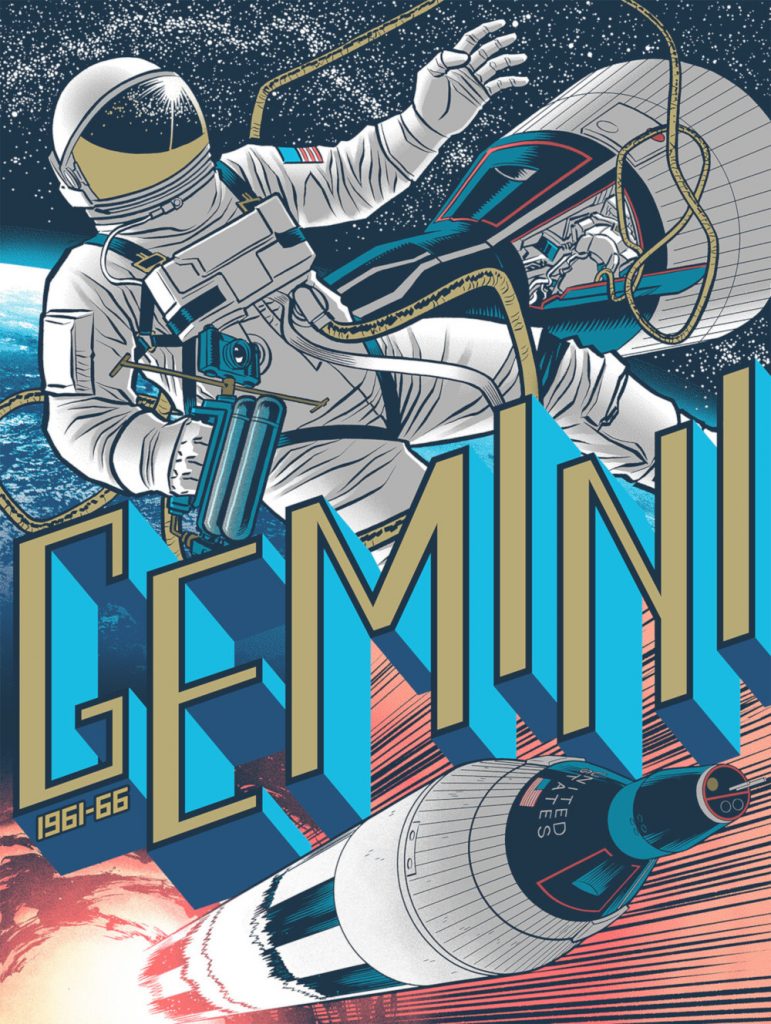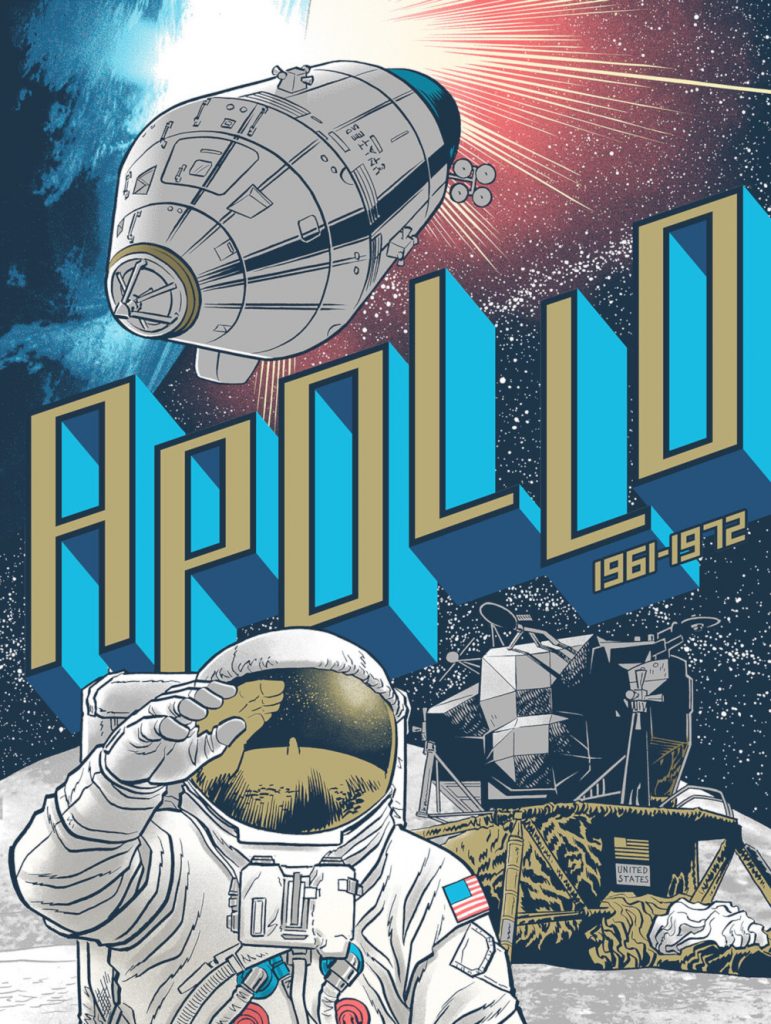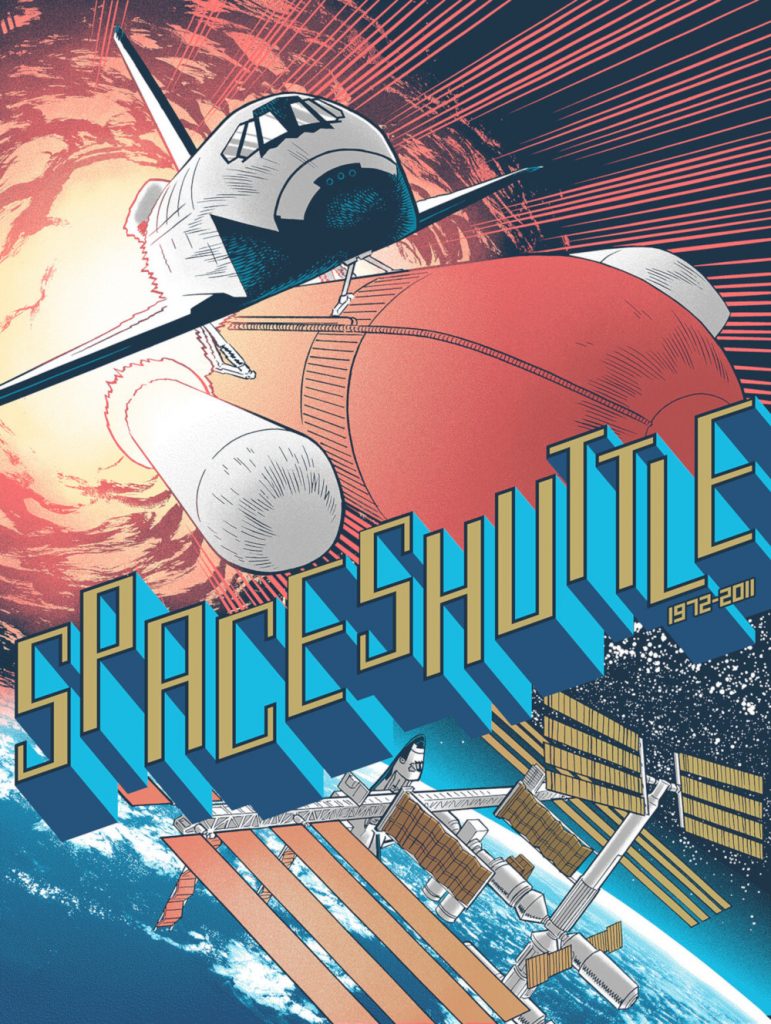“Those Things All Become Part of Who I Am”: Robert Wilson IV on Print Making and His New NASA Poster Series
If you’ve met artist Robert Wilson IV at a convention, you’re one of the lucky ones.
The Heartthrob artist isn’t just a phenomenal comic book artist, but one of the best print makers in the game today. And as you stop at his table to pick up one of his exceptionally brilliant works — which range from gig posters for musical acts like Metallica and “Weird Al” Yankovic to pieces celebrating his love of Gundam and the Alien franchise — you quickly realize that as gifted as he might be, his thoughtful, friendly ways might make him an even more likable person. He’s an absolute gem, and a must visit at any convention.
It’s not all conventions for Wilson, though, as he’s always looking to push his work in new, interesting directions. Take his recent Crowdfundr campaign for a series of screen printed posters celebrating the history of the NASA space program, with one dedicated to its four main eras: Mercury, Gemini, Apollo, and the Space Shuttle period. It was both a successful attempt at funding the work, but also a way to try new directions with his art and prints.
As a big fan of his work, and with the pre-orders on these prints ending in two weeks, I leapt at the opportunity to chat with him about his work, the position prints play in his mix of projects, the value of conventions, going with Crowdfundr instead of other options, how his love of NASA, how he views himself, and more. It’s a fun chat, and one that highlights a wonderful series of works from one of the most talented folks out there. If you dig it, make sure to pre-order one (or all) of these works, because they’re amazing prints and the campaign will be ending soon.
You can read the chat in full below. It’s open to non-subscribers. But if you do enjoy the conversation and would like to read more, perhaps consider subscribing to SKTCHD for more in this vein.
Let’s start with the basics. While you’ve always been a comic artist, prints related to varying things you love have always been a big part of what you do as well. What is it about the print form that appeals to you as an artist? Is it more about the fact that prints are an appealing thing for fans and customers at conventions, or does that form speak to you as an artist in particular?
I’ve been interested in illustration and design since college and posters (and maybe t-shirts) are an outlet for exploring that. It’s also a way for me to draw what I want to draw that doesn’t need the context of a story or a publisher to give me permissions to draw it. Having the benefit of having merch to sell online and at cons is a huge bonus that gives me more flexibility in my career.
You mentioned cons. You’re a veteran of the convention arts. We’ve talked about this before in conversation, but how important are cons to what you do as an artist? And within that, are prints a major part of that presence?
For better AND worse, conventions are a pretty big part of my business model. They provide a pretty regular income in a career where you don’t always know where your next paycheck is coming from. They are also a pretty essential social outlet for me. I love my non-comics friends, but having people in your life who understand your triumphs and struggles is so important and that’s something I pretty much only get from my fellow creators.
In my mind, and forgive me for my limited view of this, from an art standpoint, prints are probably similar to covers from the way an artist approaches them. I suppose a major difference there is one needs to represent the comic it’s on, while prints just need to be cool as heck. But I could be wrong, so let’s fix that. What’s your approach to drawing a print, from concept to finished product? Is it just a) this is a thing I like and b) this is how I see it in my head, or is it considerably more than that?
Haha, yeah man, for me, it’s almost that simple. With posters, I have a freedom that is just not possible, even with cover work. With covers, you have to represent the book, it’s a sales tool. Whereas with a non work for hire poster, I’m the client, designer, editor, and first customer. I’m making things that appeal to me and my sensibilities first and foremost. It kind of reminds me of the freedom that I had drawing as a kid.
You’ve done gig posters, Gundam prints, Alien prints, RUSHMORE prints, etc. etc. You celebrate a lot of things you like in those works. Why add NASA to that mix?
Space exploration is such a beautiful thing to me, both literally and as a cultural idea. I love the aesthetics of space exploration but I also really wanted to celebrate the collective accomplishment that the NASA’s Space Program represents. To me, it’s such an inspiring idea that humanity can set its sights on a seemingly impossible goal and accomplish it in barely over a decade. It tells me that every problem we currently face as a society COULD be overcome if we would all truly work together for the common good.
There are a number of ways you could have rolled this out. You could have went the usual route and printed them yourself and sold them at conventions alone. You could have done them as a pre-order on an ecommerce site. You could have Kickstarted them, as you did with Like a Virus. You could have done a number of things. And yet, you did this as a Crowdfundr campaign. What made that the right choice for you and this project?
I had wanted to do a crowdfunding campaign for this poster series kind of since its inception. However, there was never a good time and then when it felt right, Kickstarter made their big blockchain announcement and frankly, I want nothing to do with blockchain nonsense, even tangentially. So I thought the project might just be dead. Then Jazzlyn Stone and Dave Baker reached out to me about Crowdfundr and everything just felt right. I’m highly deadline motivated and when they said that they’d like me to be a launch partner about a month before launch I just threw myself into it. I want to work with people I like and trust and the team Crowdfundr has put together is absolutely that.
You specifically focused on four key eras of NASA: Mercury, Gemini, Apollo, and then the broader Space Shuttle era. What made doing a series celebrating its history the right fit, and what made those the key focuses in your mind?
There was just too much amazing aesthetic elements to fit into one poster. Honestly, I probably could have done two or more per period, but I also have to consider the economics of a big project like this. Each poster costs me over a thousand dollars to have printed, so I do need to have an editing eye on the project. I had actually worried that four posters might already be more than there’s demand for.
You shared your original art on the Crowdfundr page, and it was interesting to see what actually showed up as inked art and what was done digitally, especially considering when I first looked at it, I was just like, “Wow Robert is good! How did he do this?!” What was your process for bringing these to life, and how much research did you put in to ensure these were right? Because as anyone at NASA (or who is obsessed with NASA) would likely say, the details are essential for each of the aspects you brought to life.
I put a TON of research into it, at least by my standards. There are so many amazing resources out there now that just didn’t exist when I first thought of this project a few years back. I ended up using the Smithsonian’s 3D archive a lot, where you can reference 3D models of just about every component of each of the vehicles. Flickr is also such a rich resource for finding photo reference of this stuff.
You have a rainbow holofoil variant for this, which is where you really start speaking my language. I know you have a lot of fun with foils and really amping up the production value of these prints, and they typically make sense within the idea you’re working with. What made adding that variant something that made sense for this NASA series?
I think so. It’s easy to fall into thinking about space exploration as black and white ships on a black and white star field, but space is more complex than that and I’m also not a realist. I want my work to have an impressionist quality to it, to have a little romance. I think the fun thing about rainbow foil is that it takes white light and breaks it down into the entire spectrum of visible color that white light is composed of. It moves, it feels alive, it gives you a peek behind a curtain only rarely given in nature.
You’re over your goal now, with more pre-orders to come, hopefully. How does this open things up for you now? Are these NASA posters something you’re going to include in your convention mix going forward?
Yeah, that’s the model I think. Pay for production of expensive or risky projects using something like Crowdfundr and then sell the remaining stock at conventions and on my website. My whole career has pretty much been a big experiment of finding ways to make a living off of making what I want to make and this is a pretty exciting new step in that direction, it could open a LOT of interesting new doors.
Crowdfunding in general is something a lot of creators have a love/hate relationship with, if only because it’s a) super useful but also b) super stressful. But it worked here. Could you see this a path you go down again for prints, especially as you look to roll out prints for future convention seasons?
I would probably only use it for a bigger poster series like the NASA project. However, I’m very interested in self-publishing weirder comics, branching out into 3D merch, and maybe even trying my hand at a small fashion line, all of which I would definitely use something like Crowdfundr for.
Last question for you is a big one. You make comics. Cons are a big part of your mix, as we discussed before. Prints are huge for you. You’re interested in touching on other spaces, as you said in the immediately previous question. And yet, if someone described you, it’d probably be as a “comic artist,” which feels accurate and also quite limiting. What do you see yourself as? And does any single title really fit an artist today, given how much the role (and tactics) has evolved in even the last five or ten years?
I feel pretty comfortable being called a comic artist, drawing comics is what I spend most of my time doing. I’ve been writing comics recently (though none have been published yet), so I guess I have started thinking of myself more as a cartoonist, though 75% of my working life is still drawing. Honestly, I’m very comfortable being many things or being in a gray area between things. I like being a comic artist, a cartoonist, a designer, an illustrator, a print maker. I guess I look at things a bit existentially, I try to do as many things that I want to do as possible and those things all become part of who I am.




